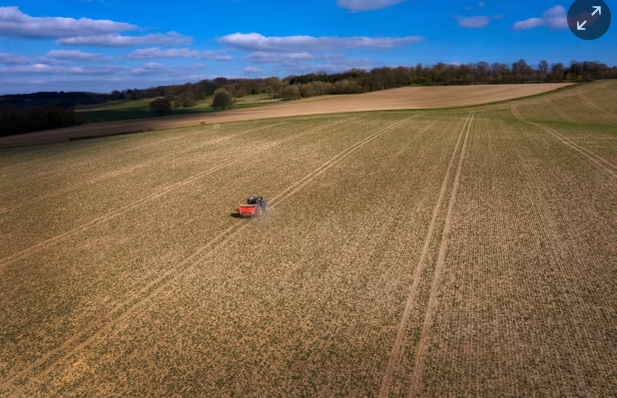May 16, 2025 | 10:21 GMT +7
May 16, 2025 | 10:21 GMT +7
Hotline: 0913.378.918
May 16, 2025 | 10:21 GMT +7
Hotline: 0913.378.918

Farmers face a dilemma: to get more flowering plant species and pollinators, the land needs to be less fertile, which reduces yields. Photograph: Nigel Francis/Alamy.
Using high levels of common fertilisers on grassland halves pollinator numbers and drastically reduces the number of flowers, research from the world’s longest-running ecological experiment has found.
Increasing the amount of nitrogen, potassium and phosphorus doused on agricultural grassland reduced flower numbers fivefold and halved the number of pollinating insects, according to the paper by the University of Sussex and Rothamsted Research.
Bees were most affected – there were over nine times more of them in chemical-free plots compared with those with the highest levels of fertiliser, according to the paper, published in the journal npj Biodiversity.
The lead researcher, Sussex University’s Dr Nicholas Balfour, said: “As you increase fertilisers, pollinator numbers decrease – that’s the direct link that to our knowledge has never been shown before.
“It’s having a drastic effect on flowers and insects. The knock-on effect goes right up the food chain,” he said.
This is primarily because fertilisers create conditions that allow fast-growing grasses to dominate, crowding out other grasses and flowers. It is generally assumed that having a greater diversity of flowers leads to a greater diversity of pollinators, which often have specialist requirements in terms of the blooms they like to visit.
The research was done in Rothamsted, Hertfordshire, on strips of grassland called Park Grass, which have been studied since 1856.
The average use of fertiliser on grassland in the UK is about 100kg for every hectare. The highest amount in the experiment was 144kg a hectare, to which the greatest pollinator declines (of 50% or more) were linked.
Even land spread with the average amount, however, had 42% fewer pollinators and five-fold fewer flowers than land with none. The results were most pronounced on plots treated with nitrogen, the most widely used type of fertiliser. Researchers found that plots treated with a fertiliser mix excluding nitrogen maintained a relatively high number of pollinators and flowers.
Almost all grassland in the UK is “improved” – meaning it is fertilised to some degree. Only 1% to 2% of grasslands in the UK are high-quality species-rich habitats, according to the study. Nationally, the UK has lost 97% of wildflower meadows since the 1930s, and studies have shown a widespread decline in numbers of pollinating insects.
Researchers also measured the productivity of each grassland plot by weighing the amount of hay produced at the end of the season. They counted pollinators such as bees, hoverflies, butterflies, wasps and flies across 18 strips of land subject to different fertiliser treatments.
Over the past decade the demand for agricultural fertiliser has increased. Prof Francis Ratnieks, an entomologist at Sussex University, said: “I visited Park Grass many years ago and realised the unique opportunity it provided to study the effect of fertilising grasslands on wildflowers and bees.
“Considering the current focus on fertiliser use, and the substantial declines in pollinator numbers over recent years, this study could not have come at a better time, as we seek to understand how landowners can best help bees and other pollinators through open grassland areas,” he said.
This study illustrates the problem farmers face: to get more flowering plant species and pollinators, the land needs to be less fertile, which reduces yields.
“Our most important and challenging finding is the existence of a trade-off between flower and pollinator diversity and grassland yield,” researchers state in the study. They highlight the need for financial incentives in the UK and EU to support biodiversity-friendly farming practices.
Balfour said: “While reduced yields aren’t typically thought of as a good thing, reducing grassland production intensity has the potential to realise many of the benefits of multifunctional landscape.” These include benefiting pollinators, improved soil health, better air quality and more resilience to extreme weather events.
Dr Philip Donkersley, a senior researcher in ecology and evolution at Lancaster University, who was not involved in the study, said: “What is interesting and novel here is the timeframes. Normally, our studies on this last four to five years. This is approaching 150 years of applying chemical and organic fertilisers, and therefore much more reflective of what has been happening on British farms.”
The Guardian

(VAN) Fourth most important food crop in peril as Latin America and Caribbean suffer from slow-onset climate disaster.

(VAN) Shifting market dynamics and the noise around new legislation has propelled Trouw Nutrition’s research around early life nutrition in poultry. Today, it continues to be a key area of research.

(VAN) India is concerned about its food security and the livelihoods of its farmers if more US food imports are allowed.

(VAN) FAO's Director-General emphasises the need to work together to transform agrifood systems.

(VAN) Europe is facing its worst outbreak of foot-and-mouth since the start of the century.

(VAN) The central authorities, in early April, released a 10-year plan for rural vitalization.

(VAN) Viterra marked a significant milestone in its carbon measurement program in Argentina, called Ígaris, reaching 1 million soybean hectares measured.